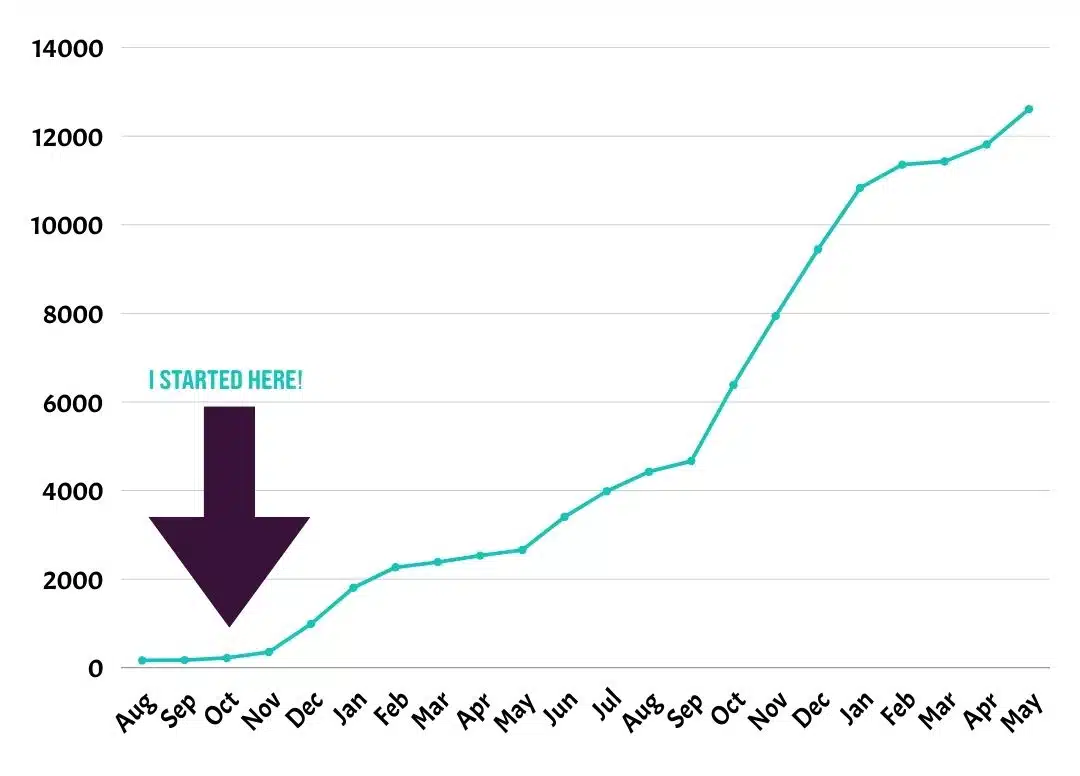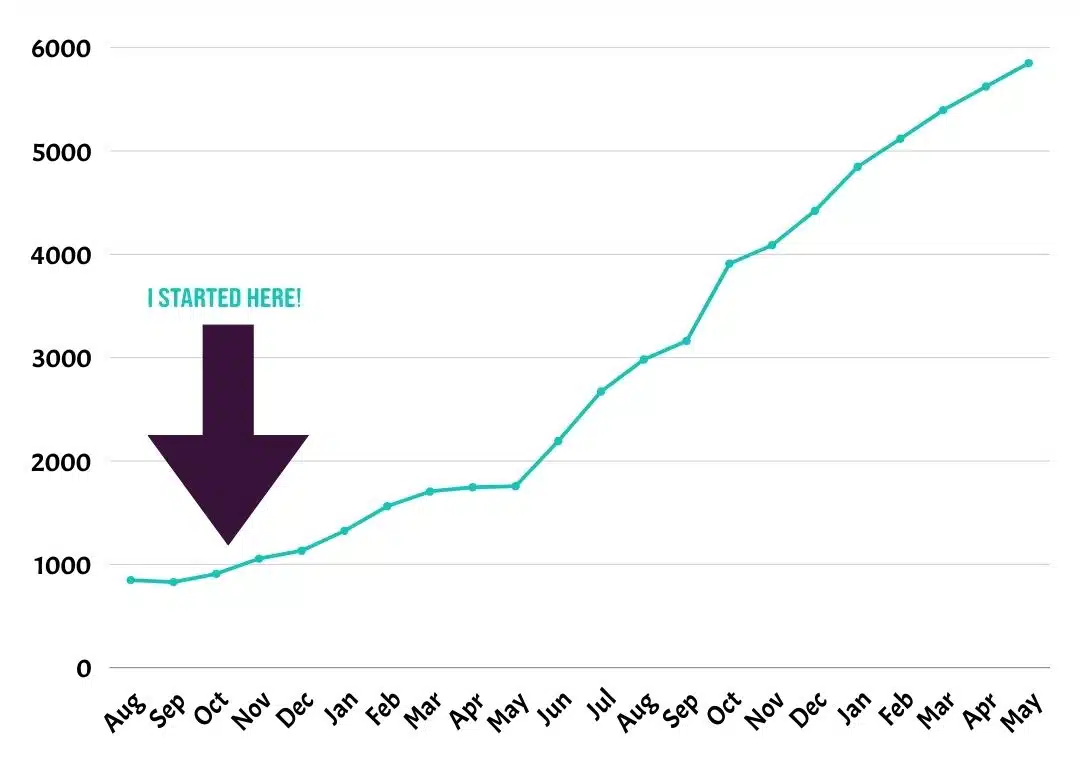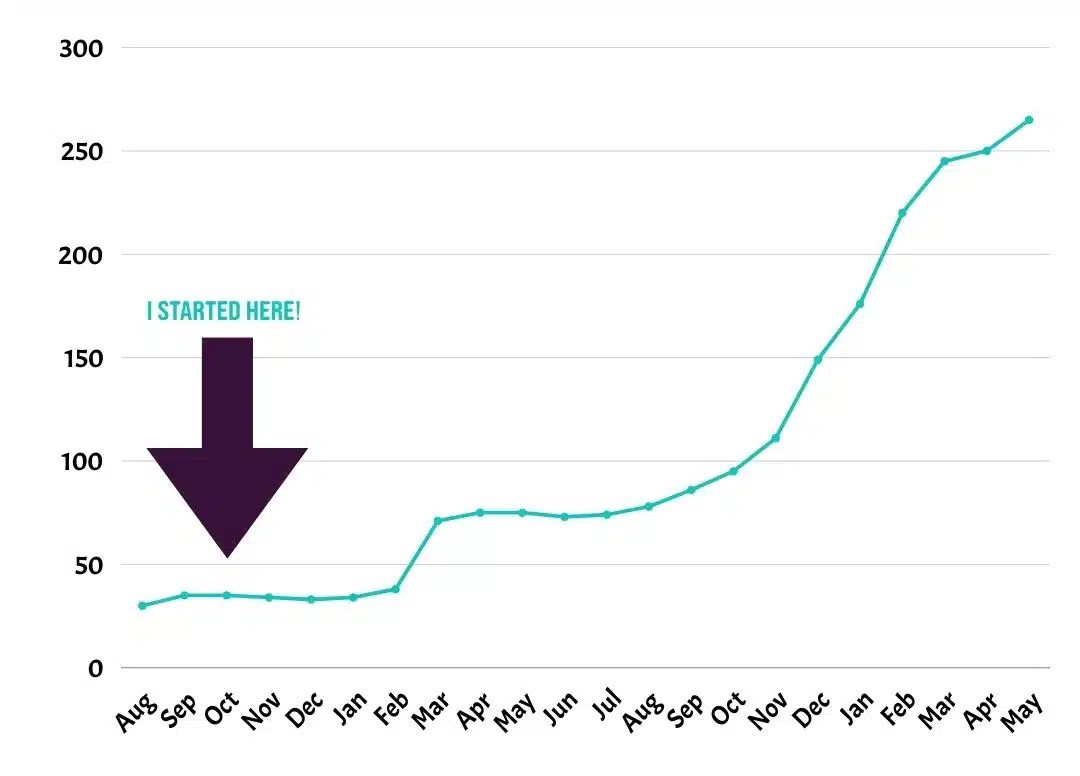Every business owner frequently finds themselves screaming a single question into the ether with alarming regularity: How Can I Get More Traffic to My Website?
And what answer does the ether provide?
Everyone says to blog. Everyone promises traffic. You just need to do all the things. The listicles on how to get more traffic to your website are honestly endless. The top-ranking post gives you 39 different tactics to try. Like, seriously? Who has the time? Who has the bandwidth, the budget, the dedicated in-house team member able to dedicate themselves to it wholeheartedly?
Yes, there are many ways to increase website traffic. But if you’re a small business, startup, or solo entrepreneur, trying to do all the things just isn’t viable.
You don’t have unlimited time, money, skills, capacity, or brain space. Frankly, you have more important things to be doing.
What you actually need is a simple, effective strategy that delivers — no fluff, no filler, no stress.
That’s exactly what I did for this client.
When we started, they were getting around 354 website visits a month. Eighteen months later, they were consistently seeing over 12.5K visits — all organic, all high-intent, all from the right people.
Now, was I… running paid ads? Writing guest blogs on a million sites? Paying for backlinks? Creating videos, optimising for mobile, improving page speed, fixing Core Web Vitals, updating old posts, launching an email newsletter, doing YouTube SEO, posting on social media, using content aggregators, guest posting on a million sites, making infographics, or collaborating with influencers?
Nope. I was not.
In fact, I wasn’t doing most of the things on that list of 39 ways to increase traffic to your website.
I was writing one blog post a week, between 600 and 800 words. Each one laser-focused on high-intent keywords, directly relevant to what the client offered. I optimised the hell out of them for local search. And that was it.
No backlinks.
No ads.
No fancy extras.
Just content — targeted, strategic, consistent.
The only tactics from that list I used were the ones baked into publishing a good blog: adding schema markup, internal links, irresistible headlines, long-tail keywords, building a resource centre, and tracking everything in Google Analytics.
The results speak for themselves.
Not a hundred hacks. Just one strategy that actually works. Here’s what it delivered — and exactly how you can replicate it.

Skip To The Best Bits...
The Traffic Explosion: From 354 to 12,612 Monthly Visitors
Over the course of 18 months, this site’s organic traffic growth was both consistent and compounding — rising from 354 visits/month to a peak of 12,612.
That’s a +3,462% increase, entirely driven by content.
No paid traffic. No technical SEO changes. No paid backlink campaigns.
What made it work?
- Steady, compounding results: Traffic didn’t spike overnight. It built gradually — with small gains in the early months and a sharp upswing around Month 10, once rankings and topical authority kicked in.
- 14 months of consecutive growth: After the initial ramp-up, the site saw over a year of uninterrupted month-on-month increases.
- Sustained performance: Unlike many campaigns that plateau or drop, this strategy held strong. Even during slower periods, rankings continued to climb — laying the groundwork for the next wave of visitors.
Your site’s path to more traffic may not look identical, but this proves what’s possible when you focus on what really moves the needle.
If you’re looking to increase website traffic without throwing money at ads or chasing every SEO trend, this kind of organic traffic growth shows how far one consistent strategy can take you.
One Blog a Week: The Entire Strategy
This client’s results weren’t powered by high volume or high spend. Just one thing, done well — every single week.
One blog post. 600–800 words. Posted consistently.
Each blog was written to serve a specific purpose: to target one core service, symptom, or question the clinic’s audience was actively searching for. No generic topics. No filler content. Just highly relevant, SEO-driven posts designed to increase visibility and drive qualified traffic.
What made the difference?
- Laser focus: Each post was centred on one high-intent topic or question. This avoided keyword dilution and maximised topical relevance.
- Strategic structure: Every blog included optimised SEO titles, meta descriptions, image alt text, and internal links to key service pages.
- User-first formatting: Clear headings, concise paragraphs, and plain-language explanations — no jargon or keyword stuffing.
- Uploaded with SEO in mind: Posts weren’t just written, they were fully integrated into the site to support rankings and on-site experience.
This is what blog writing for SEO is supposed to look like. And when done consistently, it works.
If you’re building a blog strategy to increase visibility, this approach proves that you can absolutely increase website traffic with blog content — as long as you’re targeting the right things, in the right way, with zero fluff.
Why This Works: Google’s Love Language Is Consistency
There’s a reason this worked — and it wasn’t magic.
Google rewards consistent SEO. Publishing fresh, relevant content on a regular schedule signals that your site is active, trustworthy, and useful. It’s not just about having a blog — it’s about showing up, week after week, with something valuable to say.
This is the core of a strong content strategy.
By writing one well-optimised post every week, the site gradually began to build topical authority. Each blog for this client reinforced the site’s expertise in podiatry, chiropody, massage, and related care — and over time, Google took notice. That trust translated directly into traffic and rankings.
It’s not about going viral or making noise. It’s about showing Google, repeatedly, that your website deserves to be seen.
If you’re wondering how to get more traffic to a website, this is the answer most businesses overlook: publish helpful, search-optimised content consistently — and let the compounding effect do its job.
Why do they overlook it?
Honestly? It seems too simple to actually work. If this is all it takes, why is there so much noise about all the other things?
Well, they work too. And you can do them. But do you don’t have to do them, you definitely don’t have to do them all, and you can add more in as you go to create even greater results.
Start small. Build. Google loves that shit (so do the other search engines, BTW, it’s not just the Google Gods).

What They Rank for Now
When I started, the site was ranking for just 1,055 keywords — most of them low-volume, low-intent phrases that brought little traffic. Eighteen months later, they now rank for 8,945 total keywords, with 5,851 actively driving traffic, 1,032 on Page 1, and 243 sitting in the Top 3 positions. That’s not just organic traffic growth — that’s a full-scale search presence.
This client now ranks on Google for high-value, high-volume terms that matter. That includes competitive national head terms like:
- “podiatrist” (60.5K searches/month)
- “chiropodist” (40.5K searches/month)
- “foot clinic”
- “podologist”
They also dominate longtail phrases and local SEO keywords with strong search intent — the kind that leads directly to bookings:
- “cost of custom orthotics”
- “reflexology in hand”
- “infected verrucas”
- “massage before or after workout”
- “foot stiffness in the morning”
- “verruca socks for swimming”
And this isn’t just about rankings. The site now holds featured snippets, People Also Ask boxes, image placements, and local pack positions — prime SERP real estate that boosts visibility and click-through rate.
Keyword rankings didn’t just grow in volume — they climbed in quality. The second graph above shows how the number of actively ranked terms surged alongside traffic. Rankings began to accelerate around Month 6, then spiked sharply as topical authority kicked in.
If you’re wondering what keywords should I rank for to increase visibility, this case study shows exactly how blog strategy and consistent publishing can put you in front of the right searches — nationally, locally, and across every stage of the customer journey.
Search Intent Breakdown: Targeting What People Actually Search For
This wasn’t just a spray-and-pray approach to content. Every single post was mapped to search intent, targeting the kinds of queries people actually type into Google when they need help, want answers, or are ready to buy.
Here’s how I broke it down — and how that keyword strategy delivered results:
Informational Intent
These are “how”, “what”, and “why” questions — people looking for answers. They’re not always ready to book, but they’re the audience you build trust with early.
Examples:
- what to do after a deep tissue massage
- foot stiffness in the morning
- hand reflexology massage
- massage before or after workout
Each blog post targeting this intent was short, sharp, and useful — designed to solve a problem and introduce the clinic’s expertise, while naturally linking to relevant services.
Local & Navigational Intent
These searches come from people looking for a service provider nearby — exactly the kind of high-converting, high intent keywords that matter most for local businesses.
Examples:
- podiatrist near me
- foot clinic Cheshire
- reflexology [town]
- verruca treatment clinic
Blog posts targeting these queries were packed with local modifiers, built to support local SEO, and reinforced through internal linking and location-based schema.
Transactional Intent
These searchers are ready to book — they just need to find the right provider. The goal here was to show up when people were ready to spend money.
Examples:
- cost of custom orthotics
- book chiropodist appointment
- back neck and shoulder massage benefits
These posts balanced information with action — combining helpful content with clear calls to book, linking directly to service pages and contact forms.
This structure wasn’t accidental — it was core to the approach. Aligning content with search intent ensured that each blog post worked harder, climbed faster, and helped attract the kind of traffic that actually converts.
Featured SERP Wins: The Visibility You Can’t Pay For
This site isn’t just ranking. It’s owning prime search engine results page real estate — the kind you usually have to pay for.
Without a single ad, backlink, or PR campaign, this blog strategy secured multiple featured snippets, image placements, People Also Ask spots, and even local pack rankings. That’s serious Google visibility — and it all came from one short blog a week.
Here’s what this client’s content now appears in:
- Featured snippets — “what to do after a deep tissue massage”, “foot stiffness in the morning”, “infected verrucas”
- Image results — “hand reflexology massage”, “thai foot massage”
- People Also Ask — linked responses to niche podiatry questions
- Local Pack — for geo-specific service terms across Cheshire
- Sitelinks — giving users direct access to core service and booking pages
These placements dramatically improve click-through rate, boost credibility, and position the brand as the obvious authority — without ever spending a penny on ads or outreach.
All achieved with short, targeted blog posts optimised to meet user intent and align with Google’s preferences. That’s the kind of visibility you just can’t buy.
Local vs National Rankings: Dual Visibility Power
Most small clinics rank locally — if they’re lucky. But this one blog-a-week strategy delivered both local SEO dominance and national SEO authority, without any of the usual bells and whistles.
National SEO: Ranking for Competitive Head Terms
This site now ranks in the Top 3 for some of the most competitive terms in its industry, including:
- “podiatrist” (60.5K searches/month)
- “foot clinic”
- “podologist”
- “foot doctor”
These are broad, high-volume keywords typically dominated by directory sites or major national chains. The fact that a local business outranked them — with no brand name, no link building, and no ad spend — speaks volumes about the power of consistent, focused content.
Local SEO: Capturing Searches That Drive Footfall
At the same time, the site is crushing local business traffic from geo-specific and “near me” searches. It ranks Top 3 for dozens of longtail, local-intent keywords like:
- “foot clinic [town]”
- “reflexology near me”
- “custom orthotics Cheshire”
- “podiatrist [region]”
These are the searches people make right before booking. And the blog content — written around real services, real locations, and real questions — showed up exactly when and where it was needed.
One Blog, Two Audiences
Because every blog post was tightly aligned to a service, location, or intent, the site steadily built relevance for both national and local queries.
That’s what happens when your blog strategy speaks your audience’s language — and Google’s, too.
Traffic Timeline: The Real Time It Takes
One of the most common questions I get asked is a really obvious one: “How long does SEO take?”
Like, for reals?
This is one I’m always brutally honest about up front because the answer is one nobody wants to hear: at least six months, usually twelve. That’s not a hard and fast rule, but generally speaking you don’t start seeing real results until you’ve put in at least six months of consistent effort.
And, usually, it’s closer to a year.
But this case study is a great opportunity to answer that question of how long SEO really takes in a bit more detail. Because, like all SEO strategies, this wasn’t an overnight explosion.
It was a steady, strategic climb — exactly the kind of SEO timeline Google tends to reward.
Month-by-Month Growth Milestones
- Month 1: 354 monthly visits
- Month 6: Traffic steadily rising, but no dramatic spike yet
- Month 10: First major surge in organic traffic
- Month 14: Biggest single-month jump — +1,719 new visits
- Month 18: 12,612 monthly visitors and counting
Behind the scenes, keyword growth began early — even before the traffic spike. The site was gaining visibility, but not all rankings were high enough yet to pull in meaningful clicks. This keyword vs traffic lag is completely normal, especially with content-led SEO.
If you’re aware of this going in, it helps you avoid the pit of your stomach dropping out when you’re paying out a monthly fee and seeing nothing, or slaving away at your keyboard every week for months on end and have nothing to show for it.
Totally normal. Frustrating? Utterly. But entirely to be expected.
The Feb–Mar Plateau
Traffic growth on a website doesn’t start with traffic, its starts with rankings. And it doesn’t always follow a linear growth trajectory. In February–March (Year 2), traffic temporarily levelled off. But here’s the crucial part: keyword rankings continued to grow.
That’s not a failure — that’s the SEO plateau that often comes right before a big leap.
Think about it: early on, you’ll see minimal traffic but significant gains in keyword rankings. That goes on for a while then, bam, your traffic suddenly spikes. At some point that traffic stop spiking and levels out, while your rankings continue to climb (just as they did at the start) leading to another spike.
You ride that wave for a while, level off, then spike.
In April–May, the traffic picked back up. That’s when newer posts hit maturity, earlier rankings improved, and momentum kicked in hard.
Again, it’s useful to know this happens before you’re in the middle of it and panicking thinking you’ve done something wrong. You haven’t. Just ride it out, your traffic will start climbing again. In the interim, it shouldn’t drop; you should maintain a relatively stable amount of traffic while you plateau.
It’s like skim boarding between big waves.
Good SEO content builds in layers. Content momentum runs on a curve: slow at first, then unstoppable.
If you’re investing in content and not seeing immediate returns, don’t panic. Keep publishing. Stay consistent. The results will come — and when they do, they compound.

The Backlink Bonus: Why Great Content Earns Links on Its Own
So, why do people keep telling you to buy backlinks, beg for them, or build an entire digital PR machine just to get noticed?
Do backlinks even work?
Do I even need them?
The short answer is: yes. Absolutely.
Backlinks are a known ranking factor — one of the biggest, in fact. High-quality backlinks help build domain authority, increase website authority, and boost your visibility in search results.
But here’s the longer answer: yes, backlinks matter — but quality content attracts them naturally. You don’t need to chase them, spend a fortune, or juggle a dozen different tactics to make it happen.
Consider that, for this client:
- I didn’t buy a single backlink.
- I didn’t pitch for guest posts.
- I didn’t hire a link-building agency.
- I didn’t run any digital PR campaigns.
What I did do was publish one short, useful blog post every week — and let the content do the heavy lifting.
Was it longform? No. Did it go viral? Nope. But it was relevant, well-structured, and valuable to real people — and that’s what made the difference.
Backlinks started to appear organically. Not in massive, flashy spikes, but in slow, steady growth. Week by week, post by post, the site’s backlink profile expanded — without a single hour spent on outreach.
That’s the power of a consistent content strategy. When your blog is actually helpful, other sites start referencing it. They link to your guides, cite your answers, and send traffic your way. It’s SEO that builds on itself — quietly but effectively.
And the results speak for themselves. You can literally see it in the backlink growth chart: one blog per week, and the domain’s authority keeps climbing.
This is how to get backlinks without begging for them. This is how to earn backlinks organically, without spending a penny. And this is why content-led SEO doesn’t just drive traffic — it builds real authority over time.
Consistent SEO content = consistent link growth.
No noise. No fluff. Just steady, sustainable results.
The Takeaway
If you’re trying to increase traffic with blog posts, forget the long lists of conflicting advice. You don’t need paid ads, fancy tools, or a hundred different tactics.
What actually worked here was simple: one blog a week.
600–800 words. High-intent keywords. Strategic optimisation.
No fluff. No shortcuts. No stress.
It’s not a hack — it’s a habit. The best SEO strategy is the one you can stick to. And when you do, consistently? That’s when you get more website traffic — the kind that sticks around.
How To Get More Traffic To Your Website: Let Me Do This One Thing For You
If you’re ready to stop spinning your wheels and start seeing real results, let me take care of it for you.
- One blog a week
- Fully optimised for SEO
- High-intent keywords
- Hands-off for you
- £249/month — no contract, no fluff
This is the SEO blog writing service that actually delivers: a focused, proven blog SEO package designed to get more website traffic without the overwhelm.
Get One Blog a Week — £249/month, Cancel Anytime →


